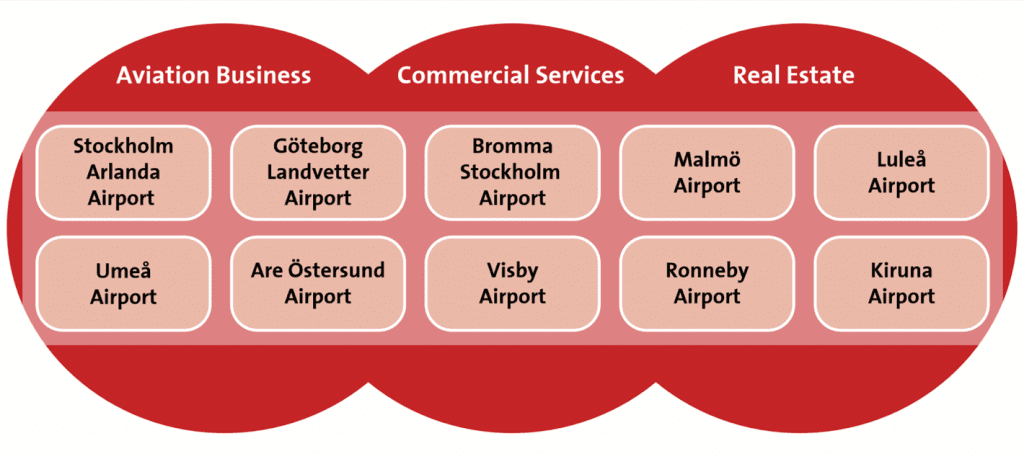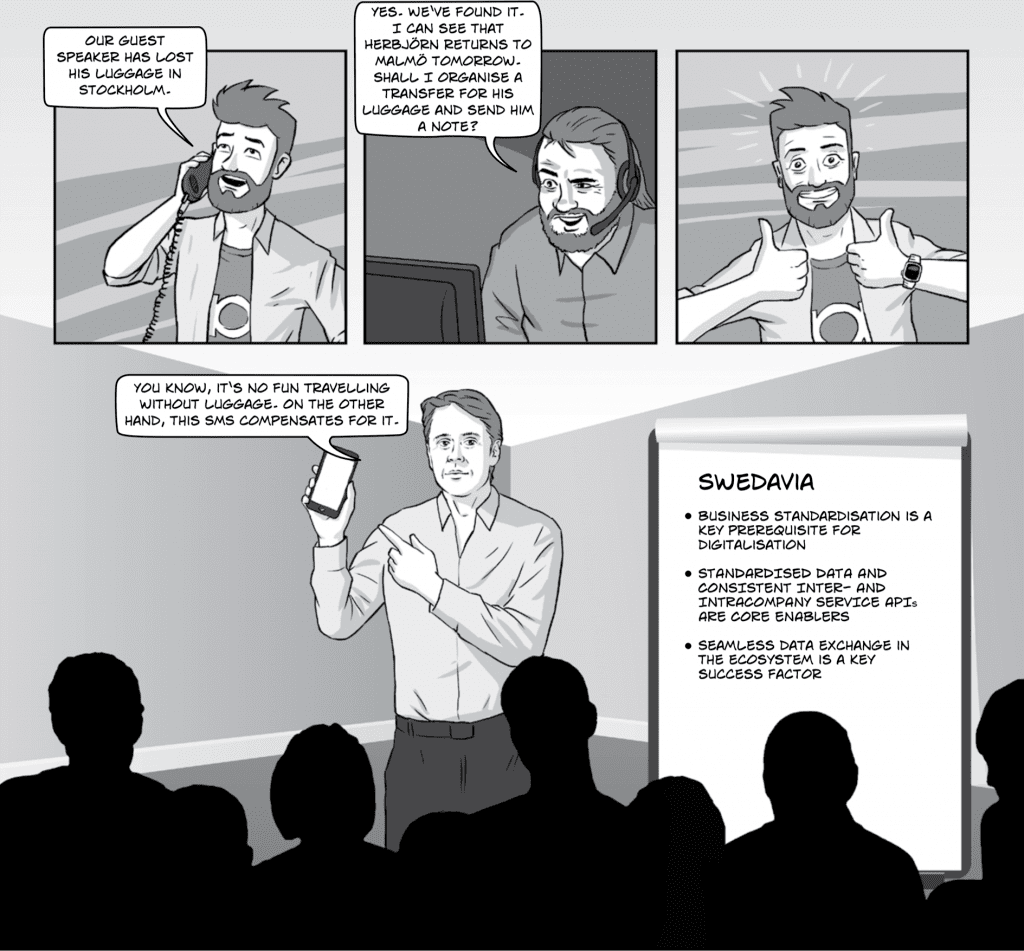Swedavia is a publicly traded company that owns and operates 10 airports in Sweden, including the international hub airport Arlanda. Even though one company owns all these airports, they operated independently in the past and therefore have multiple different ways of working and also multiple different IT systems to support them.
Operating airports is a complex business that Swedavia has divided into three different business areas – Aviation Business, Commercial Services and Real Estate.

Aviation Business revolves around managing air traffic. Complexities in this business area arise from security and environmental demands.
This business is also highly regulated by national and international laws. Significant international cooperation is necessary to ensure flight time schedules work.
Key challenges in this area include:
- Keeping track of aircraft movements and detailed time schedule information to check if flights are on time. Flight schedules may need modification.
- Keeping track of aircraft ground-handling tasks, such as refuelling, cleaning, baggage handling and de-icing. These tasks can also affect flight schedules.
- Keeping track of passengers and their baggage. Security is a main concern. Problems with passengers and/or baggage can also affect flight schedules.
- Managing aircraft movements on the ground to minimise environmental impacts.
- Sending and receiving changes to flight schedules with Eurocontrol, resulting in new time slots for flights, which may affect multiple airlines and airports as well as the airspace of several countries.
Commercial Services is all about presenting an attractive commercial offering to travellers in and around the airports, an activity that has grown all the more important for Swedavia in recent years.
Principal activities to manage in this area include:
- Offering attractive parking options, with extra services such as enhanced security and charging for electric vehicles.
- Providing high-quality restaurants and shops that are located at suitable places in the airports.
Real Estate focuses on the construction, management and renting out or sale of buildings in and around the airports.
In this area, significant attention is paid to:
- Adhering to a multitude of detailed regulations from different sources, e.g., various Swedish authorities as well as the European Aviation Safety Agency.
- Planning ahead when adapting airports, as runways, hangars and other important infrastructure must always be able to handle a certain amount of traffic.
- Proactively maintaining buildings and other infrastructure.
When Swedavia was initially planning for greater digitalisation – to allow digital information to be shared between its own airports and business units, as well as between Swedavia and other companies – it realised that a common business language was key.
Swedavia identified the fact that different companies in the same line of business apply the same concepts in different ways, and this was a major obstacle to their digitalisation efforts.
Standardisation both on the business and the IT side became a key enabler of the future strategy, e.g., all airports would use a given concept in the same way.
For this to work, concepts that are shared between different business units had to be properly defined, which presents a challenge when different business units work with different aspects of the same object, e.g., flights. Different business units refer to information on flights, but they do not need exactly the same information. When key business concepts are well defined, information structures can be designed with lower risk of there being misunderstandings. A clear design for data handling also enables IT systems to automate information exchange between business units.
Swedavia has started to develop APIs (application programming interfaces) based on a well-defined and standardised business language that will be used by staff both inside and outside Swedavia. The company increasingly treats information as a valuable asset; this is the key to business innovation. The general idea here is that when good quality information is easily accessible, energy can be directed towards innovation instead of creating complex point-to-point integration. Furthermore, some of the information published in APIs can be made accessible to external parties that can then help Swedavia innovate by creating their own business systems or consumer-facing apps. In order to manage the APIs well, Swedavia will require registration for all API consumers, based on clear agreements, and will monitor all traffic.
The APIs are essentially building blocks that together form a digital backbone for Swedavia. This backbone will provide opportunities for Swedavia and other companies to read and write information in many areas, such as flights, parking, traffic to and from airports, infrastructure monitoring, and more. As a result, Swedavia’s APIs will be a platform for future innovations.
With so much new information and innovation emerging, the need for new analytical capabilities is critical. On a positive note, all this new information provides Swedavia with the opportunity to perform analytics that was cumbersome or even impossible before the abovementioned initiatives started.
Analytics is key to improving business performance, which in turn can also lead to insights that spur new initiatives in information management and new APIs.
One additional realisation is important for Swedavia in respect of analytics. Swedavia is a responsible company; therefore, ethics play a key role in its analytical initiatives. The sheer possibility to do something does not automatically mean it is a good idea to go ahead and do it. Any analytical project will therefore be carefully considered before it is cleared for take-off.

